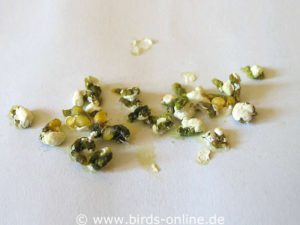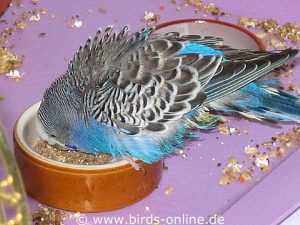- >>
- Birds Online – English
- >>
- Health and diseases
- >>
- Infectious diseases and diseases...
- >>
- Avian gastric yeast (Macrorhabdosis)
Avian gastric yeast (Macrorhabdosis)
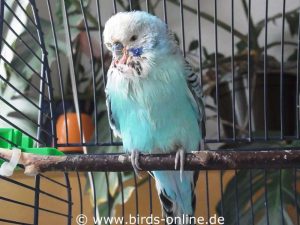
Among the infectious diseases affecting budgies and other pet birds, there is one that appears quite often. It had different names over the past few years. Nowadays it is called Avian gastric yeast (AGY) or Macrorhabdosis. Before that, the term Megabacteriosis was common and it was also called going light (GL). All these terms describe the same serious disease, in which the infected birds lose a lot of weight in the acute phase. In this article, you will learn what causes the disease, how it can be treated, and why it’s so dangerous.
Above all, budgies are frequently affected by this infectious disease. However, it also occurs in other bird species such as Cockatiels or Lineolated parakeets. Macrorhabdosis is contagious and often occurs intermittently so that an affected bird can be temporarily free of symptoms. It is therefore often wrongly assumed that it is a healthy bird, who – if at all – has overcome a supposed minor ailment herself or himself, or has never felt bad at all. Therein lies a high risk, because if a bird suffering unnoticed from the disease moves into a new flock, she or he can transmit Macrorhabdosis to the new mates. This is one more reason why bird keepers should be familiar with Avian gastric yeast. The disease is very complex and it is therefore important to know all aspects.
Symptoms of acute Macrorhabdosis
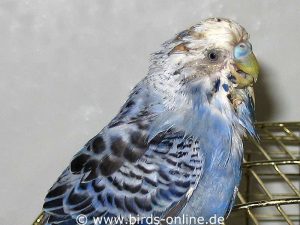
During a flare-up (an acute phase of illness), the affected usually appear ill. Their need for resting is high, the body temperature is often a little too low and the feathers are fluffed up. The birds try to keep themselves warm by doing so and move as little as possible in order not to waste any energy.
Typical for an acute flare is usually: A bird affected by this eats excessively much and nevertheless loses weight. This happens because the inflamed digestive system is no longer able to properly digest the food. Many birds also suffer from severe and repeated vomiting. So they choke up mucus and undigested food. Furthermore, undigested sees are found often in the droppings of many affected birds. Although one sees the birds often standing in front of the food dish and could assume, they would eat enough, many birds starve, because their body doesn’t gain enough energy from the little quantities of food they eat.
What causes this disease?
According to current knowledge, so-called Megabacteria, which colonize the birds’ digestive system, is responsible for the above-mentioned symptoms. Contrary to what the name of the pathogens suggests, however, they are not large bacteria but yeast fungi. They were only thoroughly examined in 2004. The experts recognized that these organisms belong to a yeast fungus species that hasn’t been scientifically described so far at this time. So they were finally discovered and named Macrorhabdus ornithogaster. The term Macrorhabdosis derives from their scientific name. This is the name that is used today to describe an infestation with these pathogens. Another common name is Avian Gastric Yeast as mentioned above.
For a long time, it was assumed that the presence of Megabacteria in the birds’ bodies alone is responsible for the outbreak of the disease. But many cases of illness showed that it usually takes further additional factors for an acute outbreak. In interaction with other diseases or factors that harm the birds’ immune system, an outbreak of Macrorhabdosis can result. One major factor seems to be massive stress. Besides, various diseases affecting the internal organs are often observed at the same time as Macrorhabdosis. If the birds show vomiting, this can be caused by Macrorhabdus ornithogaster alone or by interaction with other pathogens. For example, if bacteria occur simultaneously, avian vets refer to these pathogens as a secondary infection which is in fact a second disease occurring at the same time.
Does an infestation mean that each affected bird becomes ill?
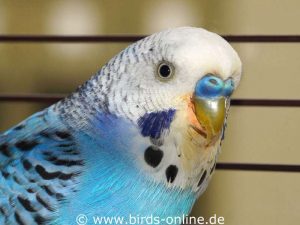
As already described above, a bird who is infected with Macrorhabdus ornithogaster is not in each case ill or even in deadly danger. However, if Macrorhabdosis has actually started and is not detected in time, it can often be fatal quickly, although treatment options are available. For example, the pathogen can be treated with a drug that has to be administered to the mouth (beak). The progression of the disease can thus be stopped in many cases. The dosage should be determined by an avian vet for the individual case, so I will not give any general information regarding the dosage here.
The duration of treatment depends on the individual case as well. I have always treated my affected birds for four weeks, but in some cases, a shorter therapy period is sufficient, whereas I have also heard of longer treatment periods.
One crucial point you have to be aware of as a bird keeper is: A full recovery and healing can, unfortunately, be achieved very rarely. The only thing I could do for my affected budgies was to stop the disease from progressing. But at some point, unfortunately, there were repeated relapses, which often ended fatally despite immediate treatment.
Symptoms not always specific
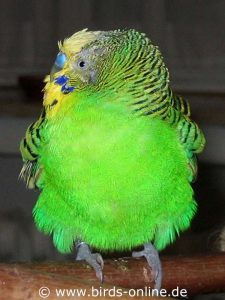
If a bird has to throw up frequently, many owners assume that their feathered friend suffers from Macrorhabdosis. But this is not necessarily the case, because the symptom of vomiting is also typical for some other diseases. In case it occurs and there are also undigested seeds in the droppings, it could well indicate Macrorhabdosis. Nevertheless, other causes can also be responsible for the excretion of undigested seeds, such as inflammation of the intestines.
In case a bird is suspected of suffering from Macrorhabdosis, she or he should immediately be thoroughly examined by an avian vet. This allows us to find out which pathogens cause discomfort. A reliable diagnosis is generally important for the sick bird. Usually, all diseases that lead to vomiting or undigested seeds in droppings should be treated as soon as possible.
Diagnosis of Macrorhabdosis
To detect an infestation with Macrorhabdus ornithogaster, the vet has to examine samples. For this purpose, either a smear from the crop or the cloaca or even both is examined under a microscope to detect any Megabacteria present. Or the vet will look at a fecal sample with a microscope. With correspondingly high magnification, the pathogens, which are only 40 µm long and 2 µm wide, can be detected. But please keep in mind: Macrorhabdus ornithogaster cannot always be detected in the first attempt. Sometimes several tests are necessary to find these pathogens in the samples.
Transmission of the pathogens
Macrorhabdosis is a contagious disease. One assumes for example that young budgies are probably already infected in the nest if their parents carry the pathogen. The adult birds regurgitate food from the crop to feed their chicks with it. This is how the pathogens get into the young birds’ bodies.
Adult budgies can likewise easily infect each other. This can happen when the birds are feeding their partners or when they’re just “kissing”. Besides, Macrorhabdus ornithogaster can probably also spread via the drinking water. The droppings of an infected bird who is currently excreting the pathogen are also considered a possible source of infection.
Is there any protection against Macrorhabdosis?
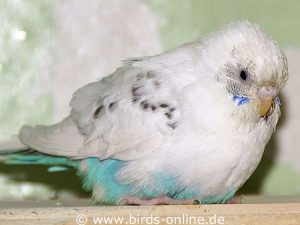
An infected budgie getting in touch with a flock or a single other bird will most likely transmit the germs. To minimize the risk, each new bird should be kept in quarantine for some time before socializing with other budgies. The animal should also be checked for pathogens by an avian vet. If it turns out that a new bird carries the pathogens, caution is advised.
Many bird owners ask themselves whether it is possible to socialize the bird nevertheless with its conspecifics and to simply watch out. But there is no way to just be careful. In case the birds live together, transmission generally cannot be prevented. This also applies when the greatest possible hygiene is ensured. Because as soon as the birds have physical contact with each other, there is a danger of infection. At least the partner of the bird carrying the germs will then also be infected. Therefore infected birds should be treated or, if possible, not even become members of a healthy flock.
Admittedly it is also to be noted that many birds unnoticedly carrying the pathogens without excreting them for a long time and without showing any symptoms. This can theoretically mean two things: Under certain circumstances, they are less infectious than assumed or they are infectious, but because the pathogens just “slumber” in the newly infected animals, a dangerous acute disease does not always occur. Both scenarios are conceivable, but an exact statement about what will happen in a specific case isn’t possible. So in general, there is a theoretical danger of infection for other birds.
What to do if there are infected birds in your flock?
Because the disease is often inactive for quite some time and can thus initially spread unnoticed among the flock members, owners are often surprised and also very worried after receiving positive test results. Apart from the bird showing symptoms, there is a high probability that other birds are also affected. To strengthen the organism of infected budgies, attention should be paid to as little stress as possible, maximum hygiene, and a balanced diet.
Chronically ill budgies who do not suffer from an acute flare-up should be served high-quality food with many nutrients. It is best to consult your avian vet for detailed advice. Your bird doctor will give you the appropriate nutritional suggestions for your animals and may also be able to recommend specific dietary supplements.
And one of the probably most important measures which one should accomplish as an owner of infected birds is weighing the feathered patients regularly. By checking their weight regularly, for example at least once per week, you will notice a possible weight loss much faster than by just looking at your birds. The plumage may hide a lot and in many cases, underweight is noticed far too late.
Acidification of the drinking water: yes or no?
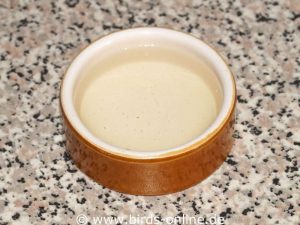
An acidic environment is unfavorable for fungi like Macrorhabdus ornithogaster. They even seem to lower the pH value of the birds’ digestive organs they colonize. To deprive the pathogens of this advantage, many vets recommend acidifying the drinking water during an anti-fungal treatment. Some doctors recommend adding 2 ml of apple cider vinegar to 100 ml of water, others suggest 3 ml of apple cider vinegar to 500 ml of water. With the help of this acidified drinking water, the pH value in the birds’ digestive tract can be increased, which should make it more difficult for the fungi to settle in the mucous membranes. Other doctors recommend grapefruit juice instead, which should have the same effect.
Here you can find an example of a study that proves the effectiveness of the apple cider vinegar therapy: Ozmen, O., Aydogan, A., Haligur, M., Adanir, R., Kose, O. and Sahinduran, S. (2013): The Pathology of Macrorhabdus ornithogaster and Eimeria dunsingi (Farr, 1960) Infections in Budgerigars (Melopsittacus undulatus). Israel Journal of Veterinary Medicine 68(4):218-224, click here.
Some doctors advise against acidification of the drinking water. They claim that it hardly helps because the body regions in which the fungi live are quite acidic anyway. Another counter-argument is that the already harmed mucous membrane can be additionally weakened by acid absorbed with the drinking water.
Please talk to your avian vet about this topic and get individual advice before you decide to acidify the drinking water of your birds or not.
Further supportive measures

The compounds in thyme can weaken the cells of Macrorhabdus ornithogaster and thus support the sick birds. Many bird keepers use thyme tea as a supportive measure in addition to the medication prescribed by the avian vet. Also, it has proven helpful to serve the tea instead of drinking water to those birds who have been shown to be ill but are not currently experiencing an acute episode. The tea can often reduce the risk of acute episodes occurring.
In addition, fresh thyme can be offered to the birds as green food. Not all animals like it, its taste is very strong. But it is worth a try. Please use preferably organic herbs or grow them yourself.
Thyme syrup is available in some countries. Of course, you can also use this and add it to the drinking water. However, it must be sugar-free.

